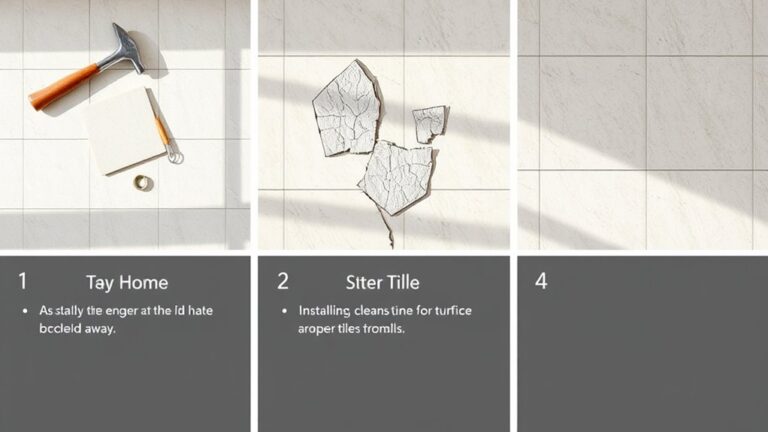To fix chipped stone tiles, start by evaluating the chip's severity and location. Thoroughly clean the area and outline it with painter's tape. For most repairs, mix a two-part epoxy or resin filler, applying it evenly into the chip with a putty knife. After it cures, sand the area with fine-grit sandpaper to achieve a smooth surface that blends with the surrounding tile. Finally, consider honing and polishing to restore the shine. This detailed process is essential for effective repairs and maintaining your tiles' appearance, and there's much more to explore on preventive measures and tools.
Understanding Natural Stone Tiles
When it comes to choosing natural stone tiles, understanding their unique characteristics is fundamental. Natural stone tiles include varieties like marble tiles, granite tiles, and limestone tiles, each offering distinct advantages and disadvantages. Marble tiles are renowned for their elegant veining patterns but are more prone to scratching. If you choose marble, you'll need to be cautious, especially in high-traffic areas.
On the other hand, granite tiles are incredibly durable and resistant to chips and cracks, making them an exemplary choice for surfaces that endure heavy use. Their robustness means they can withstand daily wear and tear, which is essential for maintaining a pristine appearance over time.
Limestone tiles present a softer aesthetic and texture, but they are more susceptible to damage, requiring careful maintenance and handling. If you opt for limestone, understanding its limitations is critical in preventing chipped tiles and other forms of damage.
In any case, knowing the properties of these natural stones aids in selecting appropriate repair strategies and materials for damaged tiles. Whether you face a chipped tile or a more severe issue, the repair process can vary considerably based on the type of stone. Therefore, recognizing the importance of keeping your natural stone tiles in ideal condition not only preserves their beauty but also extends their lifespan. By understanding these characteristics, you empower yourself to make informed decisions and take the necessary steps to maintain your stone surfaces effectively.
Common Causes of Damage
Chipped stone tiles often occur due to impact from heavy objects, which can create localized damage. Additionally, temperature fluctuations can cause the stone to expand and contract, contributing to chip formation over time. Understanding these common causes helps you take preventative measures to maintain the integrity of your tiles.
Impact From Heavy Objects
Heavy objects can pose a significant threat to the integrity of stone tiles, leading to unsightly chips and damage. Items like pots, pans, and furniture can easily cause chips when dropped or dragged across the surface. The localized impact primarily affects the edges or corners of the tiles, making it vital to comprehend how to protect your investment.
| Object Type | Potential Damage | Prevention Method |
|---|---|---|
| Heavy Furniture | Chipped edges | Use protective mats |
| Pots and Pans | Cracked tiles | Avoid dropping or sliding |
| Appliances | Corner damage | Secure with padding |
| Tools | Scratches and chips | Store properly |
Natural stone tiles, such as marble and limestone, are particularly susceptible to such damage due to their softer structure when compared to granite. To mitigate risks, regular maintenance and awareness of the weight and potential impact of objects in your space are important. If you encounter damaged tiles, you may need to contemplate repair options or replacement tiles to restore the aesthetic appeal of your flooring. Always keep the right tools handy for efficient repair work.
Temperature Fluctuations Effects
The integrity of stone tiles can also be compromised by temperature fluctuations, which cause expansion and contraction within the material. Over time, these stresses can lead to cracks and chips, necessitating professional skills to repair a chipped tile effectively. Rapid temperature changes, such as placing hot pots directly on your stone surface, can greatly increase the risk of thermal shock, resulting in immediate damage.
In areas with extreme seasonal changes, repeated freezing and thawing cycles can weaken the structure of your tiles. Additionally, moisture absorption properties of certain stones, like limestone, exacerbate this issue. Water can freeze inside the stone, creating internal pressure that contributes to cracks and chips.
To mitigate these damaging effects, regular maintenance is essential. Confirm proper installation to minimize stress points and consider sealing your tiles to reduce moisture absorption. Avoid direct exposure to extreme temperatures whenever possible. By addressing these factors, you can help maintain the beauty and functionality of your stone tiles, prolonging their lifespan and reducing the frequency of repairs. Remember, understanding the effects of temperature fluctuations on your tiles is critical in preserving their integrity.
Assessing Chip and Crack Severity
When evaluating chip and crack severity in stone tiles, it's important to identify the type of chip and evaluate the extent of the damage. Minor chips may only require a simple fill, while deeper cracks could necessitate more significant repairs or even replacement. Understanding these factors helps you choose the right repair materials and techniques for an effective restoration.
Identifying Chip Types
Chips in stone tiles can range from minor blemishes to significant defects, making it essential to accurately evaluate their severity. Start with a thorough visual inspection of the affected area. Look closely for signs of discoloration or damage around the chip, which may indicate underlying issues that could complicate repair options.
Next, focus on determining the chip's depth. Minor chips may only require a simple application of filler from your repair kit, while deeper chips could necessitate more extensive techniques. Don't forget to evaluate the chip's location; those on edges or corners can be more noticeable and might require different approaches compared to flat surfaces.
Additionally, determining the type of stone is vital. Each stone, whether it's marble, granite, or limestone, has unique properties that affect the materials and methods used for repair. Understanding these factors will help you choose the best strategy to fill the chip and restore your tile's appearance. By identifying the chip types accurately, you're better equipped to select the appropriate repair options, ensuring your stone tiles regain their original charm and functionality.
Evaluating Damage Extent
Regularly reviewing the extent of damage is essential for effective stone tile maintenance. Start by evaluating the chip severity; determine if it's a minor imperfection or a major flaw that could affect structural integrity. Conduct thorough visual inspections to gauge the depth, width, and location of the chip. This information will guide you in selecting the appropriate repair method.
When dealing with cracks, pay attention to their length and type. Hairline cracks may require different treatment than extensive cracks, which might necessitate full tile replacement. Understanding the specific characteristics of the damaged area is vital for a successful repair.
Additionally, consider the type of stone involved. Softer stones like limestone may need more delicate handling compared to harder stones like granite. Regular reviews of your tiles can help catch damage early, preventing further deterioration and ensuring timely repairs. By staying proactive, you can maintain the beauty and functionality of your stone tiles, allowing for freedom in your design choices without the worry of unseen damage.
Essential Tools and Materials
To effectively repair chipped stone tiles, having the right tools and materials on hand is imperative. First and foremost, you'll need a high-quality epoxy or resin filler. This filler is essential for repairing chips, as it provides a durable bond and is compatible with various stone types. Using a putty knife, you can apply the filler precisely into the chipped area, ensuring even distribution.
In addition to the filler, fine-grit sandpaper is required for smoothing out the repaired area. After the filler has cured, gently sand the surface to blend it seamlessly with the surrounding tile. This step is crucial for achieving a uniform appearance.
If the repair requires restoring shine, polishing pads will be an important tool in your kit. These pads help to refine the surface further, enhancing the overall look of your repair.
Don't forget about safety equipment. Always wear gloves and goggles when working with chemicals and sharp tools during the repair process. Protecting yourself should be a priority, ensuring you can work freely and confidently without the risk of injury.
Gathering these tools and materials before you start will streamline the repair process and help you achieve professional-looking results. With the right preparation, you can tackle those chipped stone tiles and restore their beauty effectively.
Step-by-Step Repair Process
Repairing chipped stone tiles involves a systematic approach to guarantee a successful fix. Start by cleaning the chipped area thoroughly with a damp cloth to remove any debris. Make sure the surface is clean and dry before moving on. Next, use painter's tape to outline the chipped area. This protects the surrounding tiles from any epoxy or filler that may spill over during the repair process.
Now, prepare a two-part epoxy by mixing the resin and hardener according to the manufacturer's instructions. It's essential to select a color that closely matches your stone tile for effective color matching.
- Feel the satisfaction of restoring beauty to your space.
- Save money and time by repairing instead of replacing.
- Take pride in your DIY skills and the results.
- Enjoy the peace of mind that comes with a job well done.
Apply the mixed epoxy into the chip using a plastic applicator, ensuring it fills the chip completely and is level with the surrounding tile surface. Once the epoxy has cured, gently sand the repaired area with fine-grit sandpaper until it's smooth and blends seamlessly with the rest of the tile.
Honing and Polishing Techniques
After you've successfully filled in the chips, honing and polishing techniques are vital for restoring the stone tiles to their original beauty. Begin the honing process by using abrasive pads, starting with a coarser grit to tackle any roughness around the repaired areas. Gradually progress to finer grits to achieve a smooth surface. This method not only evens out the finish but also prepares the tiles for polishing.
Next, you'll move on to polishing, which requires specific polishing compounds designed for your type of stone. These compounds enhance the shine and restore the original luster of your tiles. It's important to use a variable speed polisher during both honing and polishing to control the friction and prevent overheating of the stone. Overheating can lead to further damage, so keeping the speed manageable is key.
Before you plunge into the full honing and polishing process, always test your techniques on a small, inconspicuous area. This will confirm compatibility with the specific type of stone, allowing you to avoid unexpected problems. Regular honing and polishing can greatly help maintain the appearance of your natural stone tiles, extending their lifespan and reducing the visibility of chips and scratches. By properly executing these steps, you can enjoy beautifully restored stone tiles that reflect your commitment to maintaining their quality.
Preventive Maintenance Tips
Restoring the shine and smoothness of your stone tiles through honing and polishing is an important step, but ongoing preventive maintenance is equally essential to keep them looking their best. Your natural stone floor is prone to chipping, especially in high-traffic areas where everyday use can take a toll. Here are some preventive maintenance tips to help you safeguard your investment:
- Conduct regular inspections for signs of wear and damage to catch potential issues before they worsen.
- Use protective mats or rugs in high-traffic areas to provide an extra layer of protection against impacts and scratches.
- Maintain ideal humidity levels in your home to reduce the risk of substrate movement and temperature fluctuations that can lead to tile damage.
- Schedule professional cleaning and sealing of your stone tiles every few years to protect against stains and moisture penetration.
Additionally, always lift heavy objects when moving them rather than dragging them across your stone surfaces. This simple practice can greatly reduce the risk of chips and scratches. By incorporating these preventive measures into your routine, you'll enhance the durability and beauty of your stone tiles, ensuring they remain a stunning feature of your home for years to come. Your commitment to maintenance allows you to enjoy the freedom of a beautiful space without the worry of costly repairs.
Frequently Asked Questions
How to Repair Chipped Stone Tile?
To tackle chipped tile repair, start with a thorough clean of the damaged area. For effective stone tile maintenance, utilize a DIY tile solution like a tile repair kit that matches your stone's color. Apply the filler with precision, ensuring it's level with the surrounding surface. After curing, consider stone surface sealing to enhance durability and prevent tile damage. If needed, don't hesitate to seek professional tile services for more complex restoration techniques.
How to Fix a Chipped Tile Without Replacing It?
Fixing a chipped tile is like mending a broken heart; it requires care and attention. Start with tile repair methods that guarantee proper adhesion. Choose adhesive options that match your tile's color for a seamless look. Utilize restoration techniques like filling the chip with epoxy, and don't forget the sealing processes to protect your work. Finally, apply maintenance tips and surface finishing to keep your tiles looking fresh and vibrant for years to come.
Can You Touch up Chipped Tile?
Yes, you can touch up a chipped tile using various repair techniques. For effective DIY methods, consider adhesive options like color-matching epoxies to blend seamlessly with your stone finishes. First, clean the chipped area thoroughly to guarantee proper adhesion. Then, apply the epoxy and allow it to cure. For best results, light sanding can help achieve a smooth finish. Regular maintenance tips, including prompt touch-ups, can prolong the life and beauty of your tiles.
How to Fix Chipped Engineered Stone?
When you've got a chipped stone, it's like a missing piece of a beautiful puzzle. To restore it, start with surface preparation by cleaning the area thoroughly. Use an epoxy filler that matches the stone's color, applying it carefully. Once it's cured, smooth the surface with polishing tools for a seamless finish. Finally, consider sealing options for added protection. These DIY methods let you breathe new life into your cherished surfaces.




